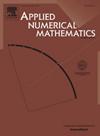A mixed discontinuous Galerkin method for the Biot equations
IF 2.4
2区 数学
Q1 MATHEMATICS, APPLIED
引用次数: 0
Abstract
The Biot model is a coupling problem between the elastic media material with small deformation and porous media fluid flow, its mixed formulation uses the pore pressure, fluid flux, displacement as well as total stress tensor as the primary unknown variables. In this article, combining the discontinuous Galerkin method and the backward Euler method, we propose a mixed discontinuous Galerkin (MDG) method for the mixed Biot equations, it is based on coupling two MDG methods for each subproblem: the MDG method for the porous media fluid flow subproblem and the Hellinger-Reissner formulation of linear elastic subproblem. Then, we prove the well-posedness and the optimal priori error estimates for the MDG method under suitable norms. In particular, the optimal convergence rate of the pressure, displacement and stress tensor in discrete norm and the fluid flux in discrete norm are proved when the storage coefficient is strictly positive. Similarly, we deduce the optimal convergence rate of all variables in discrete norm when is nonnegative. Finally, some numerical experiments are given to examine the convergence analysis.
Biot方程的混合不连续Galerkin方法
Biot模型是小变形弹性介质材料与多孔介质流体流动的耦合问题,其混合公式以孔隙压力、流体通量、位移和总应力张量为主要未知变量。本文将不连续伽辽金法与倒推欧拉法相结合,提出了混合Biot方程的混合不连续伽辽金(MDG)方法,该方法基于对每个子问题耦合两种MDG方法:多孔介质流体流动子问题的MDG方法和线性弹性子问题的Hellinger-Reissner公式。然后,在适当的范数下,证明了MDG方法的适定性和最优先验误差估计。特别证明了当存储系数c0为严格正时,离散L∞(L2)范数下压力、位移和应力张量以及离散L2(L2)范数下流体通量的最优收敛速率。同样,我们推导出离散L2(L2)范数中所有变量在c0非负时的最优收敛速率。最后,通过数值实验验证了该方法的收敛性。
本文章由计算机程序翻译,如有差异,请以英文原文为准。
求助全文
约1分钟内获得全文
求助全文
来源期刊

Applied Numerical Mathematics
数学-应用数学
CiteScore
5.60
自引率
7.10%
发文量
225
审稿时长
7.2 months
期刊介绍:
The purpose of the journal is to provide a forum for the publication of high quality research and tutorial papers in computational mathematics. In addition to the traditional issues and problems in numerical analysis, the journal also publishes papers describing relevant applications in such fields as physics, fluid dynamics, engineering and other branches of applied science with a computational mathematics component. The journal strives to be flexible in the type of papers it publishes and their format. Equally desirable are:
(i) Full papers, which should be complete and relatively self-contained original contributions with an introduction that can be understood by the broad computational mathematics community. Both rigorous and heuristic styles are acceptable. Of particular interest are papers about new areas of research, in which other than strictly mathematical arguments may be important in establishing a basis for further developments.
(ii) Tutorial review papers, covering some of the important issues in Numerical Mathematics, Scientific Computing and their Applications. The journal will occasionally publish contributions which are larger than the usual format for regular papers.
(iii) Short notes, which present specific new results and techniques in a brief communication.
 求助内容:
求助内容: 应助结果提醒方式:
应助结果提醒方式:


